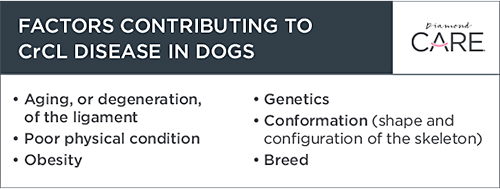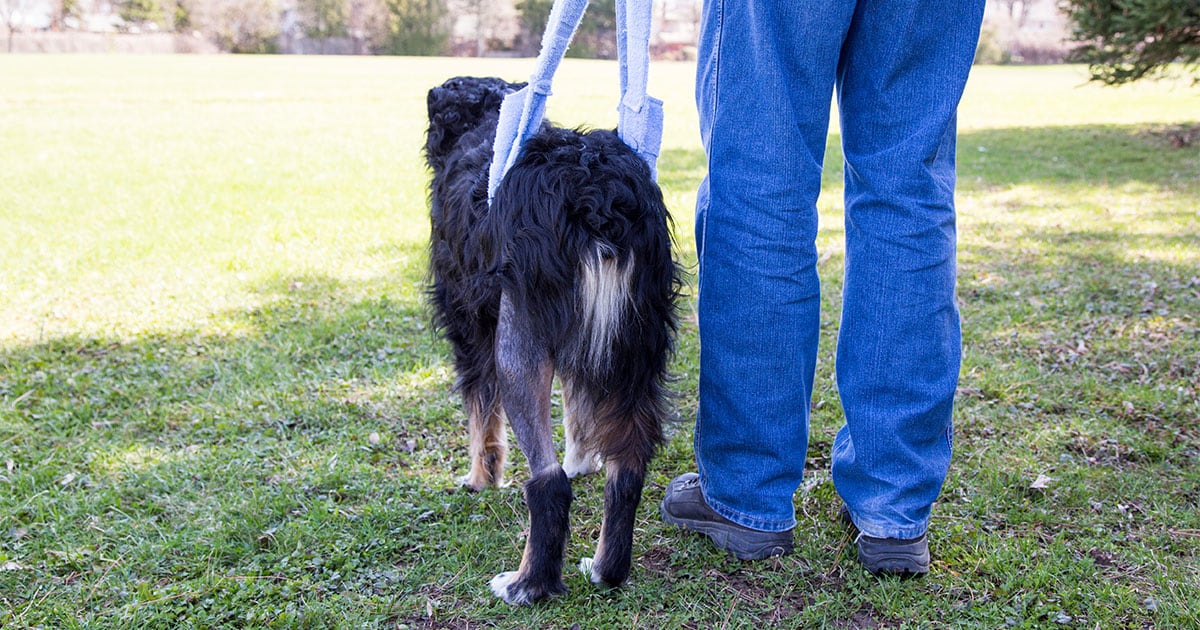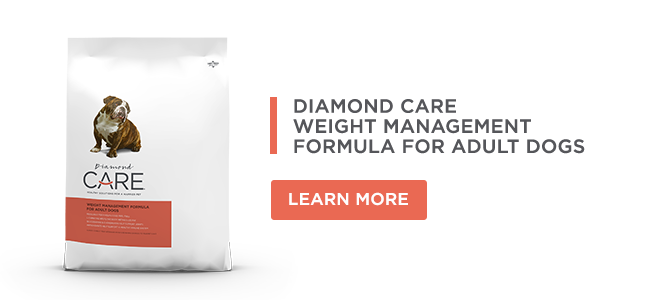Rupture of the cranial cruciate ligament (CrCL) in a dog’s stifle joint — the canine equivalent of the anterior cruciate ligament (ACL) in a human knee — is one of the most common and debilitating orthopedic problems in dogs, causing lameness and pain for thousands. A CrCL injury is also painful for a dog parent’s wallet, with one study estimating that U.S. owners spend more than $1.3 billion annually to diagnose and treat the condition.1 To learn more about CrCL injury and how you can minimize your dog’s risk, read on.
Cruciate ligaments are critical for a stable stifle
Each stifle, or knee joint, has two bands of fibrous tissue called cruciate ligaments. These ligaments, along with several others, join the femur and tibia (the bones above and below the knee, respectively) so that the stifle joint works as a hinged joint.
The cranial cruciate ligament connects the back of the femur with the front of the tibia, while the caudal cruciate ligament attaches the front of the femur with the back of the tibia. The cruciate ligaments cross inside the joint, which helps stabilize it and limits side-to-side motion. Specifically, the CrCL keeps the tibia from sliding too far forward and from rotating inward while limiting joint overextension.
Cranial cruciate ligament injury is complex and painful
According to the American College of Veterinary Surgeons, cranial cruciate ligament rupture is one of the most common causes for rear leg lameness, pain and arthritis in dogs. Many veterinarians now refer to the condition as cranial cruciate ligament disease because it’s much more complex in dogs than in people, and dogs experience different degrees of ligament rupture, or tearing.
In people, a torn ACL typically results from a twisting injury to an otherwise healthy ligament. This often occurs in athletes (like football running backs) who are running and then suddenly change direction so that the majority of their weight is placed on one knee. In dogs, ligament rupture more commonly occurs slowly over a few months or possibly years. Partial tears, or ruptures, that eventually progress to a full tear are common. Whether the rupture results from trauma to healthy or aging ligaments, the injury usually affects the cranial (or anterior) ligament. Tearing causes joint instability, significant pain and, often, non-weight-bearing lameness. Unfortunately, 40 to 60 percent of dogs who have cranial cruciate ligament disease in one stifle joint will develop a similar issue in the other.

Cranial cruciate ligament disease has been seen in all dog breeds, although it tends to occur more frequently in large-breed dogs. In one study, nearly 31,700 of more than 1.24 million dogs were diagnosed with CrCL disease. That’s a prevalence (frequency) of 2.55 percent across all breeds.2 The problem is common in some breeds — Newfoundlands (8.9 percent), rottweilers (8.3 percent) and Labrador retrievers (5.8 percent) — but unlikely in others.
Optimal weight and appropriate exercise help reduce risk of rupture
Canine CrCL disease is a problem that has steadily increased over the past 40 years,2 mirroring the trend in increased canine obesity. That’s not a coincidence, according to some veterinarians. Excessive weight has been identified as a strong contributing factor to cruciate ligament rupture, and the extra weight places added stress on joints and ligaments. In addition, many overweight dogs don’t get the exercise they need for strong, toned muscles that help support the stifle joint.
While there’s no foolproof way to prevent CrCL disease in dogs, dog parents can influence their dogs’ body weight and physical condition. Maintaining your dog at an optimal weight by monitoring their food intake is one step toward reducing the risk of orthopedic disease such as CrCL disease. Another is to provide regular activity to develop strong muscles and physical conditioning. If your dog is already an overweight couch potato, it’s not too late to take action. Be sure to talk with your veterinarian about an appropriate weight management and exercise program.
RELATED POST: Start Boosting Activity to Help Your Overweight Dog Lose Weight
RELATED POST: Why Are Our Dogs Getting Fatter?
References
- Wilke VL, Robinson DA, Evans RB, Rothschild MF, Conzemius MG. Estimate of the annual economic impact of treatment of cranial cruciate ligament injury in dogs in the United States. J Am Vet Med Assoc. 2005;227(10):1604-1607.
- Witsberger TH, Villamil JA, Schultz LG, Hahn AW, Cook JL. Prevalence of and risk factors for hip dysplasia and CCL deficiency in dogs. J Am Vet Med Assoc. 2008;232(12):1818-1824.








